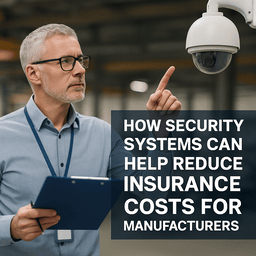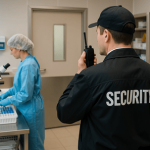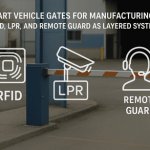
When manufacturers think about security investments—cameras, access control, alarms—it’s usually about preventing theft or keeping workers safe. But there’s another benefit that often goes overlooked: lower insurance costs.
Yes, your security system can directly influence how much you pay for property, liability, and business interruption insurance. In fact, many underwriters now factor physical security infrastructure into your risk profile—especially for industrial and manufacturing sites.
Let’s break down how this works, why insurers care, and how manufacturers can use technology (like the systems SSP installs) to lower premiums and improve coverage.
k
k
Why Insurers Care About Security Systems
Insurance providers calculate risk based on how likely your business is to file a claim and how severe those claims could be. In manufacturing environments, those risks can include:
-
Theft of raw materials or finished goods
-
Equipment vandalism
-
Fire or hazardous material incidents
-
Worker injuries or facility evacuations
-
Loss of business continuity due to emergencies
By demonstrating that you have systems in place to prevent, detect, and respond to these risks, you’re showing that your facility is a lower liability—and that means better rates.
k
k
5 Ways a Security System Helps Reduce Insurance Risk
1. Video Surveillance Verifies Events and Deters Crime
High-resolution camera systems don’t just record footage—they provide evidence.
Whether it’s a break-in, an equipment collision, or a slip-and-fall, being able to verify exactly what happened helps you defend against fraudulent claims and speed up investigations. Some insurance carriers even request specific footage during claim reviews.
Key Tip: Ensure cameras cover critical zones like entrances, loading docks, storage rooms, and high-risk work areas.
k
k
2. Access Control Creates an Audit Trail
Badge readers, door logs, and credential-based access systems make it easy to track who entered which area, and when.
That audit trail can protect your business from internal theft claims, help explain how an incident occurred, and prove compliance with safety protocols.
Many insurers view controlled access to hazardous or high-value areas as a positive risk-reduction measure.
k
k
3. Fire and Emergency Systems Trigger Faster Response
Integrated systems that tie together surveillance, alarms, voice-down alerts, and access control accelerate emergency response.
This could mean less property damage from fire, more controlled evacuations during chemical events, and quicker lockdowns when needed. All of these help minimize the scope of loss—something insurers track closely.
k
k
4. Security Footage Supports OSHA and Liability Compliance
In cases of injury or regulatory review, your archived video can help demonstrate:
-
That PPE policies were followed
-
That evacuation routes were clear
-
That proper training occurred
-
That your facility responded appropriately
By showing you're in control of safety risks, you reduce liability exposure—and may earn discounts on related insurance policies.
l
l
5. Remote Monitoring Reduces Business Interruption Risk
SSP’s remote monitoring services give manufacturers 24/7 visibility—even when the facility is empty.
That means:
-
Detecting intrusions before they escalate
-
Responding to unauthorized activity after hours
-
Getting alerts in real-time, no matter where your team is
Fewer undetected threats = fewer claims and a more favorable underwriting position.
l
l
What Insurance Carriers Are Looking For
Every policy is different, but insurers often look for:
-
Monitored video surveillance systems
-
Controlled access to restricted areas
-
Fire alarms and environmental sensors
-
Incident documentation capabilities
-
Regular maintenance of safety systems
-
Cloud-based or remote visibility features
If you can provide documentation and evidence of these features, your broker may be able to negotiate better terms—or at least help you avoid rate hikes.
k
k
SSP’s Role in Risk Mitigation
At SSP, we don’t just install cameras and access systems. We help manufacturing facilities build integrated, verifiable safety and security frameworks that stand up to both operational demands and insurer scrutiny.
From helping you map surveillance to your critical assets, to setting up centralized access logs and response protocols, our goal is to reduce your overall exposure—including financial exposure from insurance premiums.
k
k
Final Thoughts
A strong security system does more than protect people and property—it protects your bottom line. By investing in smart, well-documented, and integrated safety systems, you’re giving insurers a reason to view your facility as low-risk.
And in today’s manufacturing environment, that advantage matters.
Want to learn how your facility’s current security setup stacks up from an insurance perspective?
Schedule a security audit with SSP and we’ll walk you through your risk-reduction opportunities.


